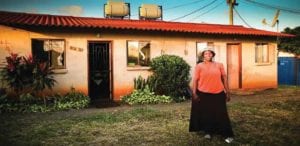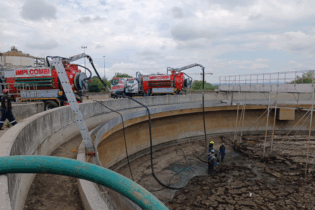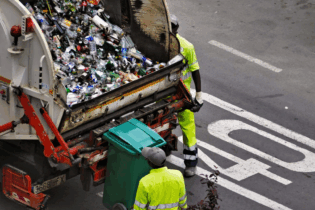According to a case study spearheaded by the Green Building Council of South Africa (GBCSA), if three million existing low-income houses were converted to ‘green’ homes, the electricity saving would be enough to power a city the size of Durban or Cape Town – proving that sustainable development is the way of the future. RéSource takes a look at this case study and what industry interprets as sustainable development.
Earlier this year, the Department of Housing approved the Comprehensive Housing Plan (CHP) for the development of integrated sustainable human settlements, known as Breaking New Ground (BNG). Since 1994, national government has built approximately three million low-cost houses, with the same target by 2025. BNG aims to, among others, eradicate informal settlements in the country in the shortest possible time. However, the materials used in these buildings have to be reusable or salvaged, and should have an extended lifespan in order to comply with the project’s sustainability requirements. Despite economic difficulties and the expensive cost of green buildings, it remains a popular trend among international countries, while in South Africa the concept is only making inroads at a fast pace in the private sector. It is for this reason that projects such as government’s BNG are saluted. International trends lean towards building automation, water conservation such as rainwater harvesting, energy efficiency and the use of non-hazardous and reusable materials. Solar power use in buildings will continue to grow, as it is still viewed as one of the simplest ways to preserve the environment. Locally, materials such as fly-ash gypsum, solar powered geysers, masonry walls (for its reuse purpose), and durable metals such as aluminium and stainless steel, dominate the green building market. But among the variety of housing construction materials available in South Africa, possibly the most widely used is concrete – and increasingly so due to its recyclable qualities. Top concrete and cement consultant George Evans of PPC addressed delegates at this year’s Southern Africa Readymix Association (SARMA) conference held in Broederstroom. He drew attention to the constant changes in client requirements, and the need for manufacturers to becomemore involved with these ever-changing demands. “In future, you will need to look at the overall fitness for purpose of the concrete you deliver to site and try to understand the other requirements that your customers might have. The world is becoming more technical and it is time to look at changing requirements with engineers in order to drive the kind of change that is required to transform our construction industry,” Evans stated. “On the Green Star rating, for example, 13% of the construction is judged on materials, of which 8% is down to innovation alone. That is proof that readymix companies can help developers get better star ratings – but only if they are prepared to innovate.” He explained that in order to make ‘green’, the industry should also look at extenders, bearing in mind that extenders should never be used on top of others in manufacturing readymix. But most importantly, manufacturers need to understand what the customer needs in terms of strength, price and green building. According to the trends“While the concept of sustainability has been around for decades, applying sustainable planning, methodology and materials to housing and community construction in a developing country like South Africa, is still considered new territory. Regardless of the take on sustainability, one thing is certain: big picture sustainability will change the way we think, the way we build and, inevitably, the way we do business,” says John Mandyck, chief sustainability officer: United Technologies Climate, Controls & Security. “As developing countries industrialise rapidly, global demand for material resources is predicted to increase dramatically. Businesses are likely to face increasing trade restrictions and intense global competition for a wide range of material resources that become less available. Scarcity also creates opportunities to develop substitute materials or to recover materials from waste, making the decision to opt for sustainable building components a wise one.” He adds: “About 51% of architects, engineers, contractors, owners and consultants participating in the World Green Building Trends SmartMarket Report 2013 (South Africa included) anticipate that more than 60% of their work will be green by 2015, up from 28% of companies in 2012. Global dialogue helps us rebalance the built environment with our natural environment. This report confirms that the green building movement has shifted from push to pull – with markets increasingly demanding no less than sustainable development.” According to the report, green building is rapidly taking hold in South Africa, with its share of companies dedicated to this area of expertise growing at a faster rate than in any other part of the world; thus South Africa moves to take its place among the leaders of green buildings. The significant expected growth suggests that South Africa may be a ripe market for green technologies, practices and solutions. Despite this viable market, the country still faces many challenges with regard to sustainable development, with the main areas of concern being high capital costs (reported by 86% of companies participating in the report) and a lack of political support (reported by 40% of companies).
Lessons learned
In December 2011, South Africa hosted the 17th annual Conference of the Parties (COP 17) international climate change talks – a widely received event that highlights, addresses and aims to tackle factors influencing climate change and global warming. Ahead of this event, a first of its kind Green Street case study was completed in a small cul-de-sac residence in Cato Manor, Durban. The project, led by the GBCSA in association with the World Green Building Council and funded by the British High Commission, saw 30 low-cost houses benefit from a sustainable upgrade, called a retrofit. The main objective of the project was to demonstrate the range of socio-economic, health and environmental benefits, which are possible from the implementation of resource-efficient interventions in low-income houses. It was also important to show that the quality of life can be improved, while still maintaining a country’s development on a low carbon and more Earth-friendly path.
• solar water heaters and related plumbing to deliver hot water directly into the house
• insulated ceilings, using 30 mm thick Isoboard to improve internal comfort levels, as well as insulation roof paint (Sno-Cote) on two demonstration houses
• heat insulation cookers to reduce cooking time on other heat sources, e.g. wood fires
• recycled furniture and fittings, e.g. old tyres and plastic containers
• efficient indoor lighting (CFL bulbs) to replace energy consumption
• LED streetlights to replace inefficient fittings
• rainwater harvesting tanks to provide water security in the event of drought or municipal shortage, as well as free water for food gardens and laundry
• food gardens to produce home-grown food
• clean up and rehabilitation of a nearby stream to remove alien invasive plants and litter, reinforce the river bank and reduce water pollution
• landscaping, using indigenous trees and plants as well as fruit trees to prevent soil erosion, provide shade and, over time, bear fruit for the community. The Cato Manor Green Street retrofit has been nothing short of life changing for its residents. The project successfully served as a strong awareness-raising tool to demonstrate the benefits of establishing resource-efficient, low-income housing. Positive results emerging from this project were better health conditions, access to hot running water, significantly lower electricity bills, rise in security level due to improved lighting, and skills transfer and training for community members, among others. If retrofits like this were done on South Africa’s three million existing low-cost houses, it is estimated that the electricity and water savings alone would be worth around R3 billion per annum (calculated at 2011 tariffs, when the project was complete). The electricity saving would be over 3 400 GWH (gigawatt hours), which is equivalent to a third of what a city the size of Durban or Cape Town uses. Some 3.45 million tonnes of carbon dioxide (CO2) would be avoided per annum from the electricity savings, thereby reducing the country’s carbon footprint. For the purposes of generating revenue on international carbon\ markets, almost 10 million tonnes worth of carbon credits are possible. In terms of employment, it is estimated that about 36.5 million person days of work could be created, which is equivalent to over 165 000 years of work. Energy efficiency interventions are often less expensive to implement than running the country’s power plants (comparing per unit cost of avoided energy with generation costs) This project’s cost benefit analysis showed that CFLs, heat insulation cookers and insulated ceilings are cheaper than the average cost of generating electricity. It is important to note that raising finance through the sale of reduced carbon emissions is possible, but limited as a funding source. However, the value would be in being able to plough such revenues back into the community for maintenance and/or development projects.








